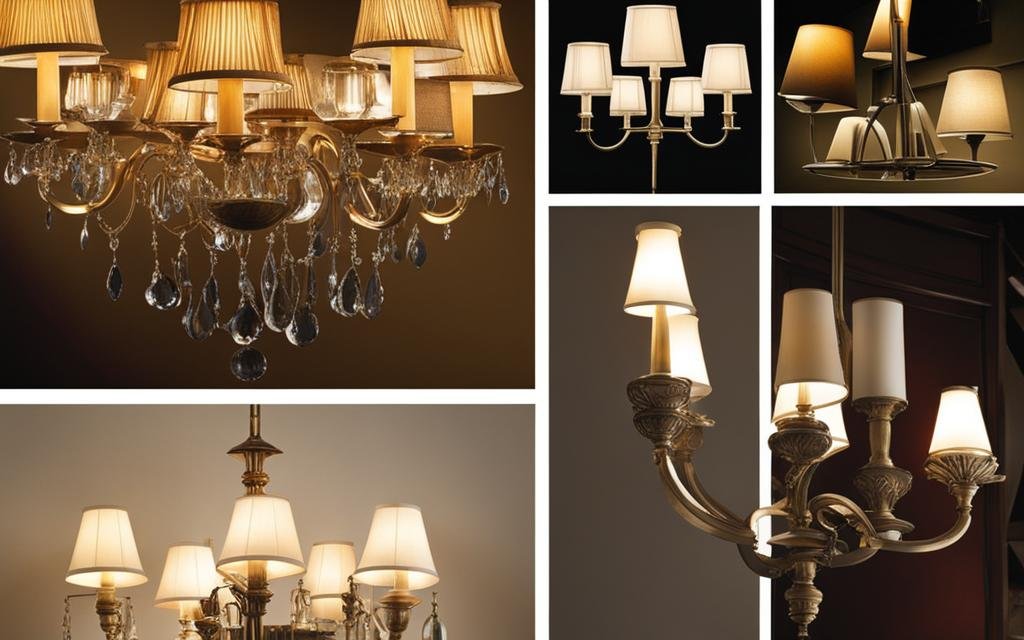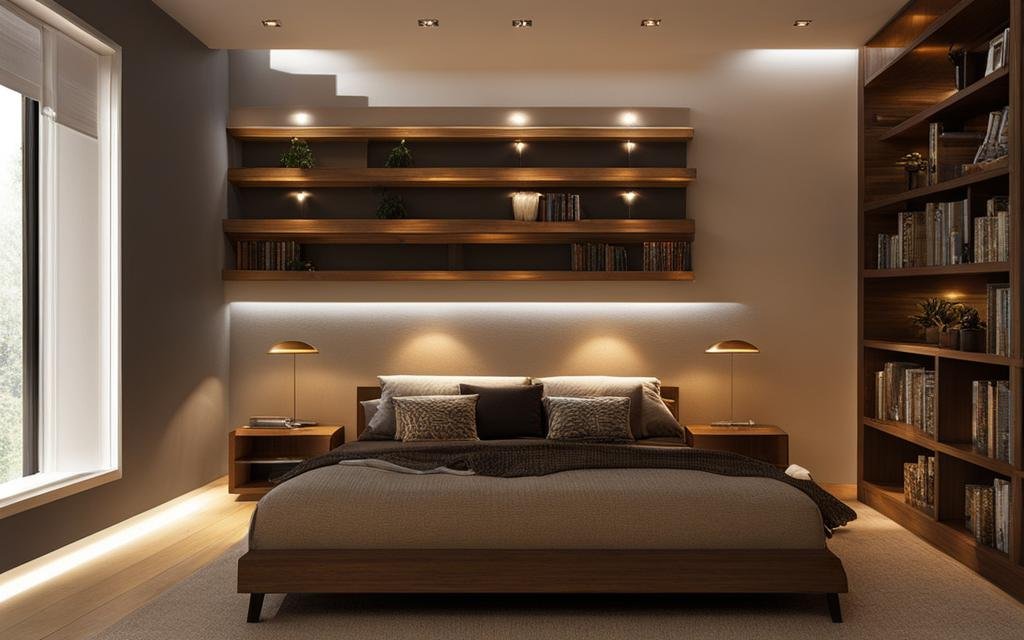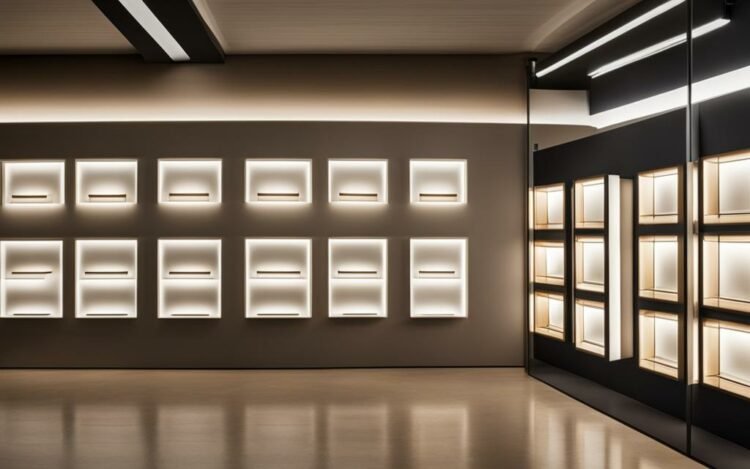When it comes to illuminating your living space, wall lights can be a stylish and practical choice. However, before you make a purchase, it’s important to consider several factors to ensure you find the perfect wall lights for your needs. In this comprehensive buying guide, we will explore everything you need to know before buying wall lights, from the different types and styles available to the importance of considering factors like color temperature and purpose.
Key Takeaways:
- Take into account the different types of wall lights available, such as out lights, down lights, and up lights.
- Consider the style of wall lights that will best complement your existing decor, such as modern, minimalist, or traditional.
- Choose wall lights that are suitable for each specific room in your home, taking into account factors like brightness and functionality.
- Pay attention to the color temperature of wall lights and select warm-toned or cool-toned lights to create the desired ambiance.
- Understand the different purposes that wall lights can serve, such as task lighting, accent lighting, and ambient lighting.
Types of Wall Lights
When it comes to wall lights, there are various types and styles to choose from, allowing you to find the perfect lighting solution for your space. Understanding the different types of wall lights available can help you make an informed decision that complements your interior design. Let’s explore some of the most popular types of wall lights:
1. Out Lights
Out lights, also known as wall sconces, are fixtures that project light outward, illuminating the surrounding area. These lights are often used for general or ambient lighting and come in various shapes and sizes to suit different decor styles.
2. Down Lights
Down lights, as the name suggests, direct light downwards. These lights are commonly used for task lighting or to highlight specific areas or objects in a room. They are often found in kitchens, bathrooms, or as bedside reading lights.
3. Up Lights
Up lights, on the other hand, cast light upwards, creating a soft and atmospheric ambiance. These lights are ideal for accentuating architectural features or creating a warm and cozy atmosphere in living rooms, bedrooms, or dining areas.
4. Up/Down Lights
Up/down lights offer the best of both worlds by providing both upward and downward lighting. These versatile fixtures can be used to create a balanced lighting scheme that adds depth and visual interest to any room.
5. Adjustable Lights
Adjustable lights allow you to customize the direction of the light beam, giving you flexibility in illuminating different areas of a room. These lights are often used for task lighting, reading nooks, or artwork displays.
When choosing wall lights, it’s important to consider the specific lighting needs of your space and the style that complements your overall decor. Whether you prefer a modern, minimalist look or a more traditional, vintage aesthetic, there are wall lights available to suit every taste and preference.

Choosing the Right Wall Lights for Different Rooms
When it comes to choosing wall lights for different rooms in your home, it’s important to consider both functionality and aesthetics. Each room has its unique lighting requirements, and selecting the right wall lights can enhance the overall ambiance and functionality of the space. Here are some tips to help you make the right choices:
1. Wall Lights for Bedrooms
In the bedroom, wall lights play a crucial role in creating a soothing and cozy atmosphere. Consider installing wall lights on either side of the bed to provide task lighting for reading or relaxing. Opt for wall lights with adjustable brightness levels, so you can easily switch between bright light for reading and soft light for winding down.
Furthermore, if you have a vanity in your bedroom, wall lights placed above or beside the mirror can provide adequate lighting for grooming and applying makeup.
2. Wall Lights for Living Rooms
In the living room, wall lights can serve as both functional and decorative elements. Consider installing wall sconces or uplights to provide ambient lighting and create a warm and inviting atmosphere. Wall lights with dimming capabilities are ideal for living rooms, as they allow you to adjust the light intensity based on the occasion and mood.
If you have artwork or architectural features that you want to highlight, consider using wall lights with adjustable beams or directional lights to draw attention to these focal points.
3. Wall Lights for Other Rooms
For kitchens, consider wall lights that provide bright and focused task lighting above countertops, sinks, and stoves. Wall lights with adjustable heads or swing arms are particularly useful in the kitchen, as they allow you to direct light precisely where it’s needed.
When it comes to outdoor spaces, choose wall lights that are designed to withstand the elements. Look for weather-resistant materials and opt for wall lights with motion sensors for added security and convenience.
Remember, the number of wall lights you install in each room will depend on the size of the space and the specific lighting requirements. Consulting with lighting experts can help you make informed decisions and ensure that you choose the right wall lights for your home.
Saving Tip: Looking to upgrade your home with new ceiling lights or wall lighting sconces? Before you checkout, be sure to explore available discounts such as an Urban Ambiance coupon code, which could help you save on your order.
Choosing the Right Wall Light Colour Temperature
When it comes to choosing wall lights, one important factor to consider is the colour temperature. The colour temperature of a light bulb refers to the warmth or coolness of the light it emits. This can have a significant impact on the overall ambiance and mood of a room. So, how do you choose the right wall light colour temperature for your space?
First, let’s explore the difference between warm-toned and cool-toned wall lights. Warm-toned lights have a yellowish or orange hue and are often associated with a cozy and inviting atmosphere. They are ideal for creating a relaxing ambiance in areas such as bedrooms and living rooms. On the other hand, cool-toned lights have a bluish or whitish hue and provide a brighter and more energizing light. These are great for areas where you need focused lighting, such as kitchens and home offices.
When choosing a wall light colour temperature, it’s essential to consider the existing color palette of the room. If your room features warm colors like reds, oranges, or earth tones, opt for warm-toned wall lights to create a harmonious and inviting space. Conversely, if your room has cool colors like blues, greens, or grays, cool-toned wall lights can complement the overall aesthetic. It’s important to avoid mixing and matching different colour temperatures in the same room, as this can create an inconsistent and jarring lighting effect.
Choosing a Wall Light Based on Its Purpose
When selecting wall lights for your space, it’s important to consider their intended purpose. Wall lights can serve various functions, including task lighting, accent lighting, and ambient lighting. Understanding these purposes will help you choose the right wall lights to create the desired atmosphere in your room.
Wall Lights for Task Lighting
If you need focused lighting for specific activities, such as reading or working at a desk, wall lights can serve as excellent task lighting sources. These lights are typically mounted at eye level and provide directed illumination to assist you in your tasks. Consider wall lights with adjustable heads or swing arm designs, allowing you to position the light exactly where you need it most. This eliminates shadows and enhances visibility, making your tasks easier and more enjoyable.
Wall Lights for Accent Lighting
Accent lighting is used to highlight specific objects, architectural features, or artwork in a room. Wall lights can be an excellent choice for accent lighting, as they can be strategically placed to draw attention to focal points. Consider using wall lights with adjustable beams or spotlight designs to create dramatic effects and add depth to your space. Whether it’s a beautiful painting or a unique architectural detail, accent lighting with wall lights will bring attention to the elements that make your room special.
Wall Lights for Ambient Lighting
Ambient lighting provides overall illumination to create a warm and inviting atmosphere in a room. Wall lights can contribute to the ambient lighting by softly illuminating the walls and bouncing light off the ceiling. This indirect lighting effect helps to create a cozy and comfortable ambiance. Consider wall lights with diffusers or shades that provide a soft, gentle glow. Wall sconces with dimming capabilities are also ideal for adjusting the light levels to suit different moods and occasions.
By understanding the different purposes that wall lights can serve, you can make informed decisions when selecting the right lighting for your space. Whether you need task lighting for specific activities, accent lighting for focal points, or ambient lighting for an inviting ambiance, wall lights can play a crucial role in enhancing the overall look and feel of your room.

Installing and Removing Wall Lights
Proper installation of wall lights is essential to ensure their functionality and safety. Whether you’re adding new wall lights to your space or replacing existing ones, it’s important to follow the correct installation process. Here is a step-by-step guide on how to install and remove wall lights:
Installing Wall Lights:
- Start by turning off the power to the circuit you’ll be working on. Locate the circuit breaker in your electrical panel and switch it to the “off” position.
- Measure and mark the desired location for your wall light. Make sure to consider the placement of other objects or furniture in the room.
- Using a stud finder, locate the studs in the wall where you’ll be installing the wall light. This will provide stability and support for the fixture.
- Drill a hole in the wall for the wiring. Make sure the hole is large enough to accommodate the wires without damaging them.
- Connect the wires of the wall light to the corresponding wires in the electrical box. Follow the manufacturer’s instructions and use wire connectors to secure the connections.
- Gently push the wires and the wall light into the electrical box, making sure not to pinch or damage the wires.
- Secure the wall light to the wall using the provided screws and brackets. Make sure the fixture is snug and level.
- Turn the power back on at the circuit breaker and test the wall light to ensure it’s functioning properly.
Removing Wall Lights:
- Start by turning off the power to the circuit where the wall light is installed. Always prioritize safety when working with electrical components.
- Remove the screws or brackets that secure the wall light to the wall. Gently detach the fixture from the wall, being careful not to pull on the wires.
- Disconnect the wires of the wall light from the electrical box. Again, use wire connectors to secure the connections.
- Once the wires are disconnected, remove any remaining screws or brackets and carefully take the wall light off the wall.
Keep in mind that if you’re not experienced or comfortable working with electrical components, it’s always best to consult a professional electrician for installation or removal. They can ensure that the job is done safely and correctly, giving you peace of mind.

Conclusion
After reading this wall light buying guide, you now have a comprehensive understanding of the factors to consider when purchasing wall lights. By taking into account the different types of wall lights, choosing the right color temperature, considering their purpose in each room, and understanding the installation process, you can make an informed decision that suits your needs and enhances the aesthetics of your space.
Remember, selecting the right wall lights is essential for creating the desired ambiance and functionality in your home. Whether you’re looking for task lighting, accent lighting, or ambient lighting, there are various options available to meet your requirements.
When purchasing wall lights, it’s important to consult with lighting experts if you have any specific concerns or need further guidance. They can provide valuable insights and help you make the best choice for your space.
So, take your time, explore different styles, and consider the factors discussed in this guide before purchasing your wall lights. By doing so, you can transform your living spaces, adding both practicality and style to create a welcoming and well-lit environment.

